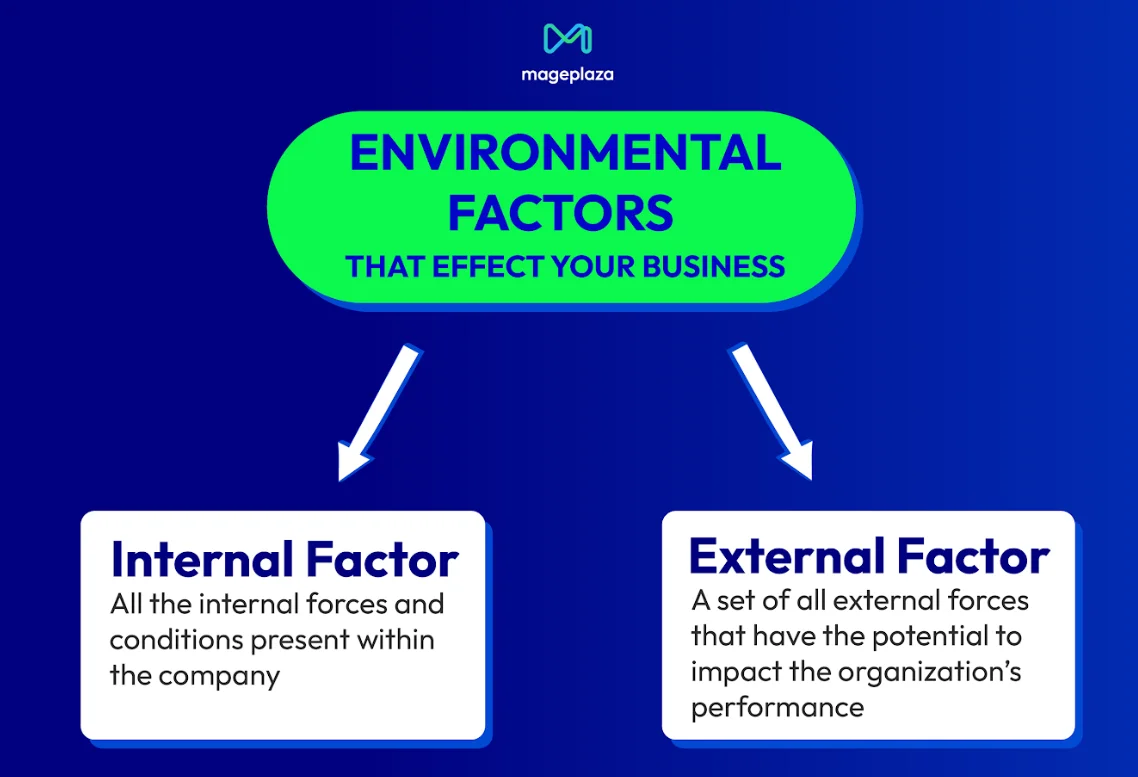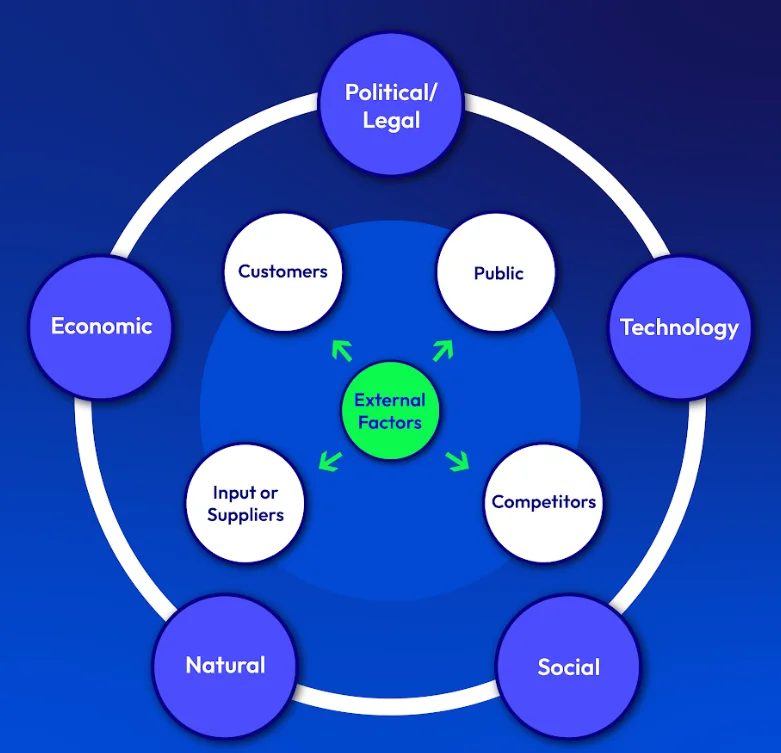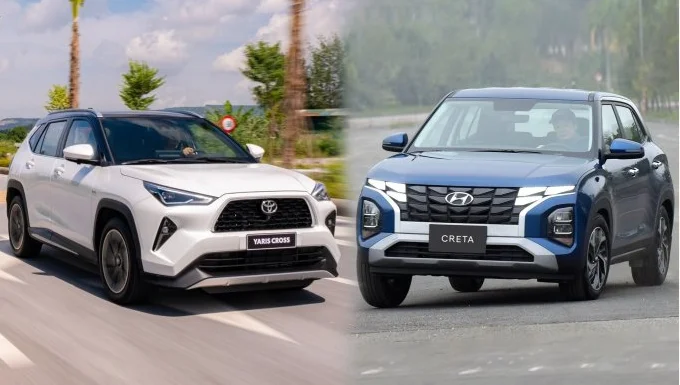Internal & External Factors in the Business Environment

Environmental factors significantly influence business operations and decisions. Recognizing them is crucial for strategic planning and risk management, aligning strategies with market conditions, mitigating risks, and adapting to changes effectively. This understanding also facilitates seizing opportunities, complying with regulations, optimizing resources, and improving customer satisfaction, thereby supporting informed decision-making and sustainable business growth.
Environmental factors that affect businesses can be broadly categorized into 2 main types:
- Internal factors
- External factors

This article aims to clarify the nature of each internal and external factor, improving operational efficiency and innovation, while also ensuring long-term sustainability and competitiveness.
Internal and External Environmental Factors - What are They?
First, you need to understand that there is a variation of internal and external factors depending on the size, type, and business status. However, you can find those key factors by analyzing the business environment using the following categories:
Internal Environment Factors

Internal factors include everything within the company’s control, whether physical or abstract. These factors are divided into strengths and weaknesses. Strengths are things that benefit the company, while weaknesses hold it back. Many different aspects of the company need to be carefully considered when evaluating these factors.
External Environment Factors

Unlike internal factors, external elements are factors outside the company’s control. Considering the external environment enables businesses to adjust their marketing plans to better fit these conditions. This may involve developing a new Amazon product photography strategy for product advertising, finding reliable partners for investments, or refining the original business plan.
Comparison Chart Between Internal and External Factors
Here is the comparison chart of Internal and External Environmental Factors:
| Aspect | Internal Factors | External Factors |
|---|---|---|
| Definition | All the internal forces and conditions present within the company. | A set of all external forces that have the potential to impact the organization's performance, profitability, and functionality |
| Nature | Controllable | Uncontrollable |
| Include | Strengths and weaknesses | Opportunities and threats |
| Impact | Company only | All companies in the industry |
Important Internal Environment Factors
1. Human Resource

In today’s global economy, where economic value increasingly comes from ideas and digital skills rather than physical resources, human resources are crucial for businesses. The success of a company depends on its employees’ skills, competencies, attitudes towards work, and performance. Skilled and motivated workers are key assets to any enterprise. However, employees who lack training and show negative attitudes present challenges. Effective human resource management is essential for both company success and employee development, requiring strategic leadership from the CEO.
2. Capital Resources
Financial capital is crucial for a business’s growth and sustainability. CEOs invest it in tangible assets like factories and equipment, and intangible resources such as marketing and employee training. Without capital, companies can’t survive. With enough funds, they can launch projects, expand, and achieve great results. For example, in 2010, Coca-Cola spent 2.9 billion USD on marketing, more than Microsoft and Apple’s combined marketing budgets, showing the importance of significant investment and stable finances for success. Companies can maintain stable budgets through investments, funding, and annual income.
3. Vision, Mission, and Objectives
Vision outlines the long-term goals and aspirations of the enterprise, showing what it aims to achieve. Mission describes the organization’s purpose, its business activities, and the reason for its existence. Objectives are specific milestones set to be accomplished within a certain timeframe using available resources.
4. Value System
A value system is a set of consistent and logical principles adopted by a firm to guide its behavior and decision-making in various circumstances. It serves as a standard for regulating conduct within the organization.
5. Plans and Policies
Plans and policies are vital internal factors guiding organizational operations and decisions. Plans define strategic goals and necessary steps for growth, while policies establish rules for organizational behavior and operations. Together, they ensure consistency, efficiency, and accountability across the organization, aiding in resource management, risk reduction, and alignment with long-term objectives. Regular reviews and updates enable organizations to stay agile and responsive, fostering sustainable success and resilience to external dynamics.
6. Organizational Structure
To have a suitable organizational structure requires the owners have to consider carefully set up a business management system to work smoothly within the company. Whether it is a centralized or decentralized system, the most important thing is how effective the structure is when applied for the company. The heads of departments or fractional CIOs need to make sure that the information flow is widely conveyed to all customers. Suitable rules and regulations are being applied to ensure the benefits of employees, and the business as well.
7. Infrastructure
When you already have well-trained and motivated workers, an effective operational and organizational system, make sure that the infrastructure of the company are good enough for all your functions. With the modern and high quality facilities, stable power, internet and wifi connection, and so on your company is likely to perform better. In other words, the better your infrastructure, the more opportunities for your company to perform successfully.
8. Innovation
In today’s competitive marketplace, no company can thrive without adopting new ideas and technology. Innovation, whether from within the organization or external sources, boosts productivity, reduces costs, enhances competitiveness, improves brand value, and increases turnover. Companies that fail to innovate risk losing market share, profits, and key employees. To benefit from innovation, businesses must plan, encourage, and strategically invest in innovative initiatives.
9. Marketing Resources
Marketing resources encompass the tools, budgets, and personnel dedicated to promoting a business’s products or services. This includes everything from advertising campaigns and market research to social media management and brand development. Effective marketing resources help a company increase its market share, build brand recognition, and attract and retain customers. Without strong marketing resources, a business may struggle to compete and communicate its value proposition effectively.
10. Tangible and Intangible Assets
Tangible assets are physical items owned by the company, such as land, buildings, machinery, and inventory. Intangible assets include non-physical resources like research and development, technological capabilities, marketing strategies, and financial resources.
11. Corporate Image and Brand Equity
Corporate image and brand equity are crucial internal factors that influence a company’s success.

Corporate Image is the comprehensive perception of a company or organization within the community, formed from the ideas, perceptions, and evaluations of the public, customers, shareholders, and employees about that company. Brand equity represents the value of the brand based on consumer recognition and loyalty. Both play significant roles in shaping the company’s reputation and competitive advantage.
12. Financial Forecasting
Financial forecasting is essential for businesses. It predicts future financial outcomes based on past data, current trends, and market conditions. It aids in budgeting, risk management, and decision-making regarding investments and expenses. By forecasting revenues, expenses, and cash flows, businesses can allocate resources effectively, monitor performance, and adapt strategies as necessary. This process promotes financial stability, supports growth, and enhances transparency with stakeholders by communicating clear financial expectations.
Important External Environment Factors
Micro Factors
1. Customers
The customer factor is crucial to business success, involving an understanding of customer needs, preferences, and behaviors. This requires identifying customer segments and tailoring marketing strategies accordingly. Analyzing buying patterns and decision-making processes helps align offerings with expectations. Building strong relationships through excellent service and personalized interactions enhances satisfaction and loyalty. Effective CRM and retention strategies, such as loyalty programs, are essential for maintaining a loyal customer base. Additionally, understanding customer lifetime value and using targeted acquisition strategies ensure sustainable growth by attracting and retaining high-value customers.
2. Input or Suppliers
The “Input or Suppliers” factor is crucial in supply chain management, involving the sourcing of essential materials and services. Reliable suppliers ensure timely, quality inputs at competitive prices, impacting production efficiency and cost management. Strong supplier relationships can result in better terms and collaborative innovation. Managing risks like supplier reliability and supply chain disruptions through diversification and contingency plans is vital. Effective supplier management enhances operational stability and overall business success.
3. Competitors
The “Competitors” factor is crucial for shaping strategic decisions and market positioning. Analyzing competitors’ strengths, weaknesses, market share, pricing, and products helps identify opportunities for differentiation and innovation. Monitoring competitors’ tactics allows companies to adapt and stay competitive. Awareness of emerging competitors and industry trends enables proactive responses. Effective competitor analysis and strategy maintain a competitive edge and drive growth in a dynamic market.

4. Public
The public includes various groups such as local communities, non-governmental organizations (NGOs), and other stakeholders who can influence or be influenced by the company’s activities. Public opinion can affect a company’s reputation and its ability to operate smoothly within a community.
Macro Factors
5. Economic
The “economic” factor includes inflation, interest rates, economic growth, exchange rates, and consumer confidence, all of which affect businesses by influencing purchasing power, costs, and market demand. Businesses adjust pricing and strategies in response to economic shifts like inflation or recession. Economic stability boosts confidence and investment, while volatility poses risks such as fluctuating costs or reduced spending. Monitoring economic trends and policies helps businesses foresee changes, and make informed decisions for sustained growth and profitability despite uncertainties.
6. Political/Legal
Political and legal factors involve government policies, regulations, and legal issues that affect a company’s operations. These include tax policies, trade restrictions, labor laws, and environmental regulations. Political stability and legal compliance are essential for business continuity and risk management.
7. Technology
Technological factors refer to innovations and advancements in technology that can affect production processes, product development, and market competitiveness. Staying updated with technological trends can lead to improved efficiency and new business opportunities.
8. Social
Social factors include demographics, cultural trends, lifestyle changes, and societal values. Understanding social dynamics helps companies tailor their products and marketing strategies to meet the evolving needs and preferences of their target audience.

9. Natural
Natural factors encompass environmental and ecological aspects such as climate change, natural resource availability, and environmental sustainability. Companies must consider their operations’ environmental impact and adopt sustainable practices to ensure long-term viability and compliance with environmental regulations.
Read more: Micro And Macro Environment Factors That Affect Your Business
Key Different Between Internal and External Factors
The internal and external environments are two crucial concepts that influence everything from the way a business operates to the success of a living organism. Here are the details:
Focus:
- Internal Environment: This refers to the factors within an organization or system that it has some level of control over. These elements include its structure (management hierarchy, departments), culture (attitudes, values), and resources (human capital, finances, technology). By effectively managing these internal aspects, an organization can improve its efficiency and effectiveness.
- External Environment: This encompasses all the factors outside the organization’s direct control. These include market conditions (competition, customer demands), economic trends (inflation, interest rates), technological advancements, and social and political forces (regulations, cultural shifts). While businesses can’t directly control these external forces, they can adapt their strategies to navigate them.
Level of Control:
- Internal Environment: Businesses have a significant degree of influence over their internal environment. They can make decisions about staffing, resource allocation, and implementing new processes. While not everything can be perfectly controlled (e.g., employee turnover), proactive management can significantly shape internal dynamics.
- External Environment: The external environment is constantly changing and presents challenges that organizations need to respond to. Businesses can’t control economic downturns, for example, but they can develop strategies to weather them, like cost-cutting measures or product diversification.
Impact:
Both internal and external environments significantly impact how an organization functions and achieves its goals.
- A strong internal environment, with a motivated workforce and efficient processes, allows a business to capitalize on opportunities presented by the external environment.
- Conversely, a weak internal environment, such as poor communication or a lack of resources, can hinder a company’s ability to adapt to external changes.
Conclusion
When applying internal and external environmental factors in business, it’s essential to consider how both affect operations. Internal factors like culture and resources influence strategies and decision-making. External factors such as market trends and regulations create opportunities and threats. By analyzing and integrating both, businesses can develop informed strategies that align with market demands, enhance resilience, and support sustainable growth.






![Top 20+ Must-have Shopify Apps for 2025 [Free & Paid] - Mageplaza](https://cdn2.mageplaza.com/media/blog/must-have-shopify-apps/top-must-have-shopify-apps.png)
![[2025 Updates] Top 10+ Upsell Apps for Shopify - Mageplaza](https://cdn2.mageplaza.com/media/blog/best-upsell-shopify-app/cover.png)